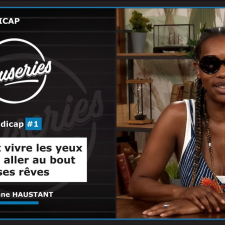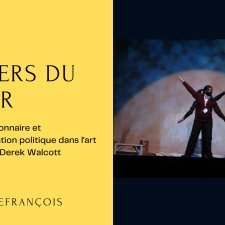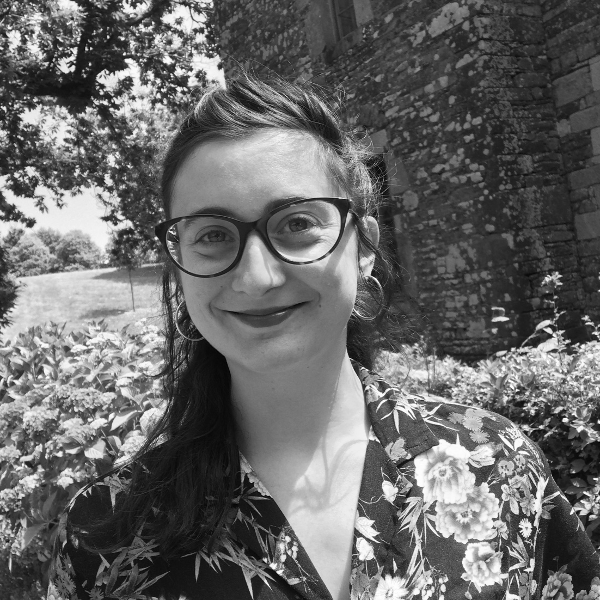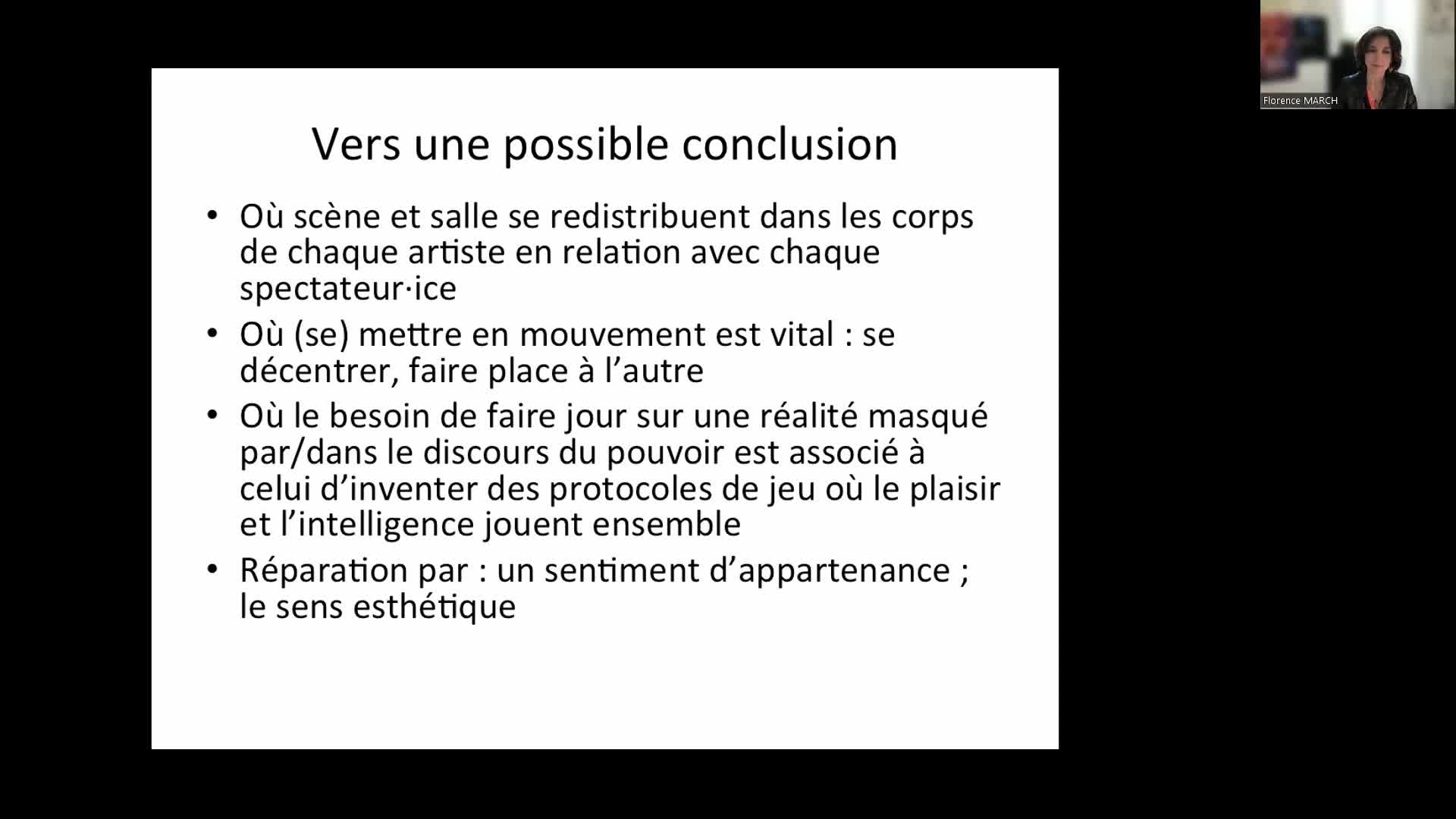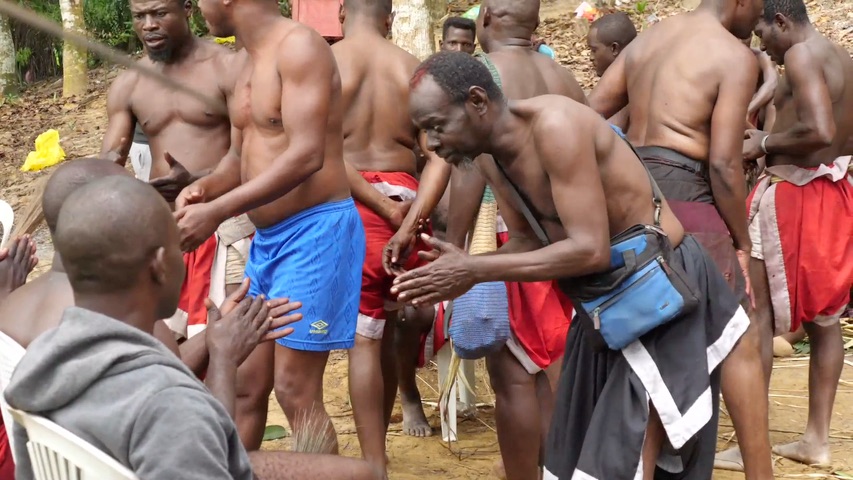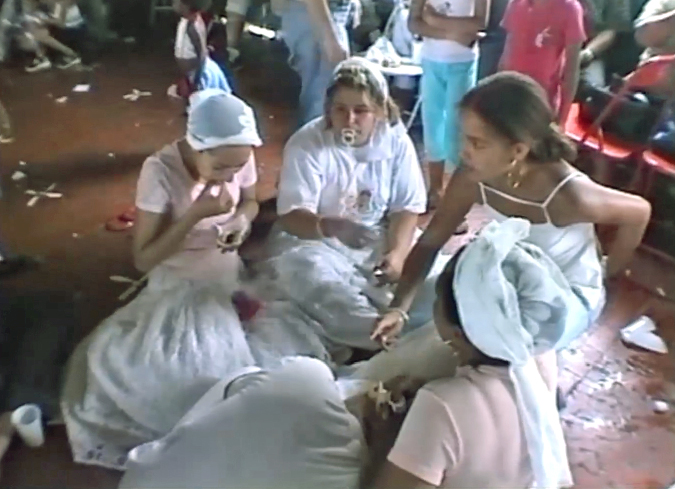Notice
“Quantifying JI”Short talk 1.1: Saul Albert - Extemporary movement: an interactional account of partner dance improvisation
- document 1 document 2 document 3
- niveau 1 niveau 2 niveau 3
Descriptif
Clear empirical distinctions can be drawn between joint improvisation and choreography in dance byexploring the rhythmical coordination of dancers and audience members in a partner dance performance.Novice dancers typically learn footwork patterns or ’basics’ that help them move in time to music together.Experts’ familiarity with basics, as well as conventional variations and setpiece moves form a set ofcompositional structures that can be linked together to fit complimentary rhythmical patterns in music on thefly. In a ’social dance’ performance such as the Lindy hop, (an African American vernacular jazz dance fromwhich the data for this study is drawn), dancers link together basics with setpiece moves along withmoments of joint improvisation. These improvised movements are literally extemporaneous they move outof the temporal regularities of mutually learned patterns and rely onother kinds of interactional resources and methods to achieve coordination. This paper analyses rhythmicalcoordination between dancers and audience members clapping along to a Lindy hop performance in anaturalistic setting using data drawn from a Youtubevideo. This empirical starting point enables a tractable analysis of the haptic, visual, and semantic structuresand processes used for coordinating extemporaneous dance movements. Audience members’ rhythmicalresponses to these processes also provides insight into longstanding problems of measurement and meaning in empirical aesthetics. Music and dance psychology tend to emphasise psychophysical measuresand posthoc report as proxies for aesthetic response. This paper proposes new ways to use the observablepatterns of rhythmicalcoordination to explore joint improvisation as part of an interactional sensemaking practice
Thème
Documentation
Liens
Dans la même collection
-
Joint Improvisation Meetings 2015
We understand joint improvisation as an artistic form involving two or more performers engaging in multiple real-time interactions: with each other, with the audience and with the emerging content.
-
Brain to Brain approaches to joint actions
KeysersChristianJoint actions require an ability to understand and predict the actions of others far enough into the future to have time to plan and execute matching motor programs. Here I will review experiments in
-
Operationalizing Social Neuroscience through HumanHuman and HumanMachine Interactions
DumasGuillaumeHow are neural, behavioral and social scales coordinated in real time so as to make possible the emergenceof social cognition? Answering this question requires to study the dynamics of coordination in
-
Acting together without planning ahead?
SebanzNatalieExperiments on joint action have given us insights into the mechanisms that allow people to coordinate theiractions with each other, be it making music, dancing, or cooking a dish together. One key
-
“Quantifying JI” Short talk 1.3: Ashley Walton - Musical Improvisation: Spatiotemporal patterns of …
WaltonAshleyWhen jazz musicians perform an improvisational piece of music their behaviors are not fully prescribed in advance. Nonetheless their actions become so tightly coordinated and their decisions so
-
“Beneficial JI” - Short talk 2.2: Julien Laroche - Being together when time is improvised: interact…
LarraínPabloImprovising music toghether involves coping in realtimewith unprecedented patterns of behavior of another. The goal is to achieve and share a meaningful coperformance,and this is done by interacting
-
“Improvising together” Debate
“Improvising together” Debate
-
Going into the unknown in science and art
KeysersChristianScientists must grope into the undefined place beyond the known. So must improvisation theater actorswalking onto the stage with no idea what will happen next. Improvisation theater developed
-
Carrying the Feeling
ManningErinCarrying the Feeling explores autistic Lucy Blackman’s use of “carrying” as an expressive force in herwriting. Continuing to delve into what I have called autistic perception theforce of perception
-
Improvising Interaction
HealeyPatrickEven the most tightly scripted solo performances involve improvisation; the detailed execution of each note or word cannot be completely determined in advance. In joint performances the challenge of
-
How much do jazz improvisers share understanding with each other and with their listeners?
SchoberMichael F.To what extent do collaborating improvisers understand what they are doing in the same way as each other?And to what extent do their listeners understand the improvisation in the same way as the
-
There could be ten seconds where everyone is connected and you feel really joined by the same threa…
CanceCarolineJoint actions require an ability to understand and predict the actions of others far enough into the future to have time to plan and execute matching motor programs. Here I will review experiments in
Sur le même thème
-
Danse et handicap #1 - Danser et vivre les yeux fermés : aller au bout de ses rêves
HaustantFabienneDanse et handicap #1 - Danser et vivre les yeux fermés : aller au bout de ses rêves
-
L'envers du décor: rhéthorique visionnaire et instrumentalisation politique dans l'art dramatique d…
LefrançoisFrédéricL'envers du décor: rhéthorique visionnaire et instrumentalisation politique dans l'art dramatique de Derek Walcott
-
Faire exister les nouvelles attentions : atelier de Julie Perrin et Pascale Gille
PerrinJulieGillePascalePar un atelier et une discussion, Julie Perrin et Pascale Gille soulignent comment les danseurs et danseuses continuent de faire bouger les lignes du "partage du sensible", en jouant de la frontière
-
Faire corps avec le document : les chorégraphes contemporains face aux crises et aux conflits
Cette communication se centre autour de pièces chorégraphiques qui abordent des situations de crises politiques, économiques, humaines, à travers des matériaux documentaires. Il s’agit de dresser un
-
Les formes de réparation dans les arts de la scène à l’épreuve de la Covid-19 (visio)
RiedlerJulietteBurighelGiuseppeLe webinaire propose un retour sur la journée d’étude et de pratiques artistiques " Les formes de réparation dans les arts de la scène à l’épreuve de la Covid-19 " (qui s’est déroulé le 23 mars 2022 –
-
Après la projection - Discussion autour de « Faraway My Shadow Wandered » de Liao Jiekai et Sudhee …
CheurfaCéliaJiekaiLiaoLiaoSudheeDiscussion avec les réalisateurs Liao Jiekai et Sudhee Liao, en dialogue avec Jean-Michel Butel, ethnologue, maître de conférences à l'Inalco, spécialiste des évolutions sociales et des structures
-
-
Cérémonies et rituels de l’umbanda : la fête des enfants Marília, État de São Paulo Brésil, les 13 …
JacquemotArmelleTerreiro du Vieux-noir Pai Fabiano, Marília, État de São Paulo (Brésil), les 13 et 14 octobre 2001
-
Corps dansant et corps bourgeois : la fabrique des normes au XIXe siècle
MarquerBertrandJarrasseBénédicteConférences | Vendredi 15 novembre Bertrand Marquer | La norme et l’écart : imaginaire et savoirs du corps au XIXe siècle Bénédicte Jarrasse | Corps-machines : la danse et l
-
-
-














